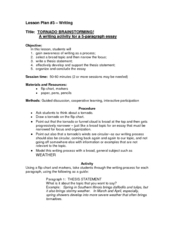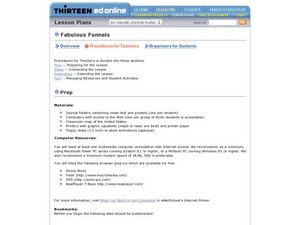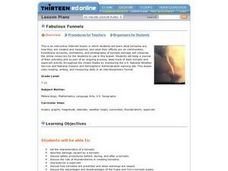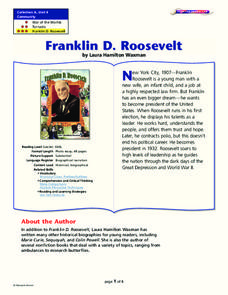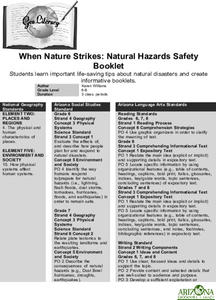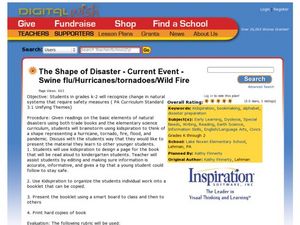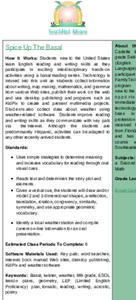Curated OER
Tornadoes
Middle schoolers examine the characteristics of a tornado. They practice using new vocabulary and participate in a question and answer session. They use the internet to gather more specific information.
Curated OER
Tornado Brainstorming
While the focus of this lesson is on writing about tornadoes, any topic could be substituted. The lesson provides a well-thought out overview of the writing process. Learners come up with a thesis statement, supporting details, and a...
Curated OER
What is a Tornado? How are Tornadoes Created? How are Tornadoes Measured?
Explore the concept of tornadoes with your class. They will research what to do during tornadoes and how to measure tornadoes. Multiple resources are included.
Curated OER
Numbers in Art
Students choose a number from one to twelve and tell a number story about it. They listen to the teacher read "Numbers in Art" by Lucy Micklethwait. Students choose three numbers from one to twelve and view works of art while looking for...
Nazareth College
Create Your Own Tornado
Third graders identify key concepts and definitions about tornados. They work in small groups of three to four to create mini-tornados. After reading Tornado Alert as a class, 3rd graders discuss tornados and fill out a KWL chart.
Curated OER
Where is Tornado Alley? Internet Research and Crossword
In this science and language arts worksheet, students are directed to an Internet site where they do research on tornadoes and Tornado Alley. Students complete a 10 question word puzzle.
Curated OER
Survival Experts
Students take on the role of survival experts as they research and produce brochures or guides to educate others about what to do in the event of a natural disaster.
Curated OER
Fabulous Funnels
Students explore what tornados are, how they are created and measured, and what their effects are on communities. They keep a journal of their activities and explorations as part of an ongoing process of learning.
Curated OER
Volunteering for Others
Students research the kind of volunteer options for teens in their area, using the Internet and calls to local agencies. Students conduct a simple survey in your school or ask volunteer organizations you contact to help you get in touch...
Curated OER
Franklin D. Roosevelt
Discuss the life of Franklin D. Roosevelt. This story, called "Franklin D. Roosevelt" by Laura Hamilton Waxman, is used to explore comprehension skills. Some of these skills include identifying prefixes and suffixes, making comparisons,...
Curated OER
When Nature Strikes: Natural Hazards Safety
Middle schoolers observe the impact of natural disasters on humans, and become aware of the dangers of environmental hazards such as flash floods, tornadoes, and hurricanes.
Curated OER
Blowing in the Wind
Pupils compare hurricanes and tornadoes. They write a paragraph explaining how to prepare for a storm. Students give an oral report. They use weather facts to practice math skills. Pupils record observations of a storm.
Curated OER
Novel Study- As You Read: Night of the Twisters
In this reading worksheet, students discover that author Ivy Ruckman doesn't describe or explain what tornadoes are in Night of the Twisters. Students jot notes as they read about what the characters experience before, during and after...
Curated OER
Night of the Twister
Students use reading strategies for Night of the Twister. In this reading strategies lesson, students name five major catastrophes and books about each. Students complete a vocabulary section, make inferences and predictions, read the...
Curated OER
The Shape of Disaster - Current Event- Swine Flu/Hurricanes/Tornadoes/Wild Fire
Learners create a disaster preparation book. For this disaster preparation lesson, students research disasters and use the kidspiration program to create a shape to represent each disaster. They create a page for each disaster.
Curated OER
Wiki Comment: The News and You
Kids explore the world of news media by creating a wiki page. They will create a wiki page on the Internet in order to comment on and question the stories that take place in the world. They will practice creative writing by summarizing...
Curated OER
Check Out Community Preparedness
Young scholars research storm preparedness in local community, identify ways citizens are notified of impending weather emergencies, contact city administrators to discuss disaster plan and whether it has ever been implemented, and...
Curated OER
Crater Creation
After looking at the back of a quarter featuring Oregon terrain, learners distinguish between fiction and non-fiction and identify the beginning, middle and end of a story. First, they listen to legends that describe the creation of...
Curated OER
Similar Similes
Investigate with your class how similes are figures of speech that use the words as and like as visual terms. They use this knowledge to complete a worksheet where they write some similes of their own. Be sure to download the attached...
Curated OER
Understanding Cause and Effect
Identify the author's organizational pattern for expressing ideas. After reading an article on the California Gold Rush, middle schoolers determine the author's purpose for writing a passage of informational text. A full list of...
Prestwick House
Connotative vs. Denotative Meanings
Besides the dictionary definition, words also carry the added weight of meanings that are inferred or implied, meanings conferred on words, or connotations. To gain an understanding the importance of connotation, class members engage in...
Curated OER
Spice Up the Basal
Fifth graders study English reading and writing skills as they participate in exciting interdisciplinary hands-on activities using a basal reading series.
EngageNY
Building Background Knowledge and Making Inferences: What Is a Natural Disaster?
That's a disaster! Scholars complete a gallery walk to view images and make inferences about natural disasters. They fill out a note catcher about what they observe and infer any questions they may have. They then participate in a World...
Curated OER
Checking Out Community Preparedness
Students research storm preparedness in their community. They interview city officials to determine the current emergency plans, warning systems, etc. Students write an analysis of the situation.



